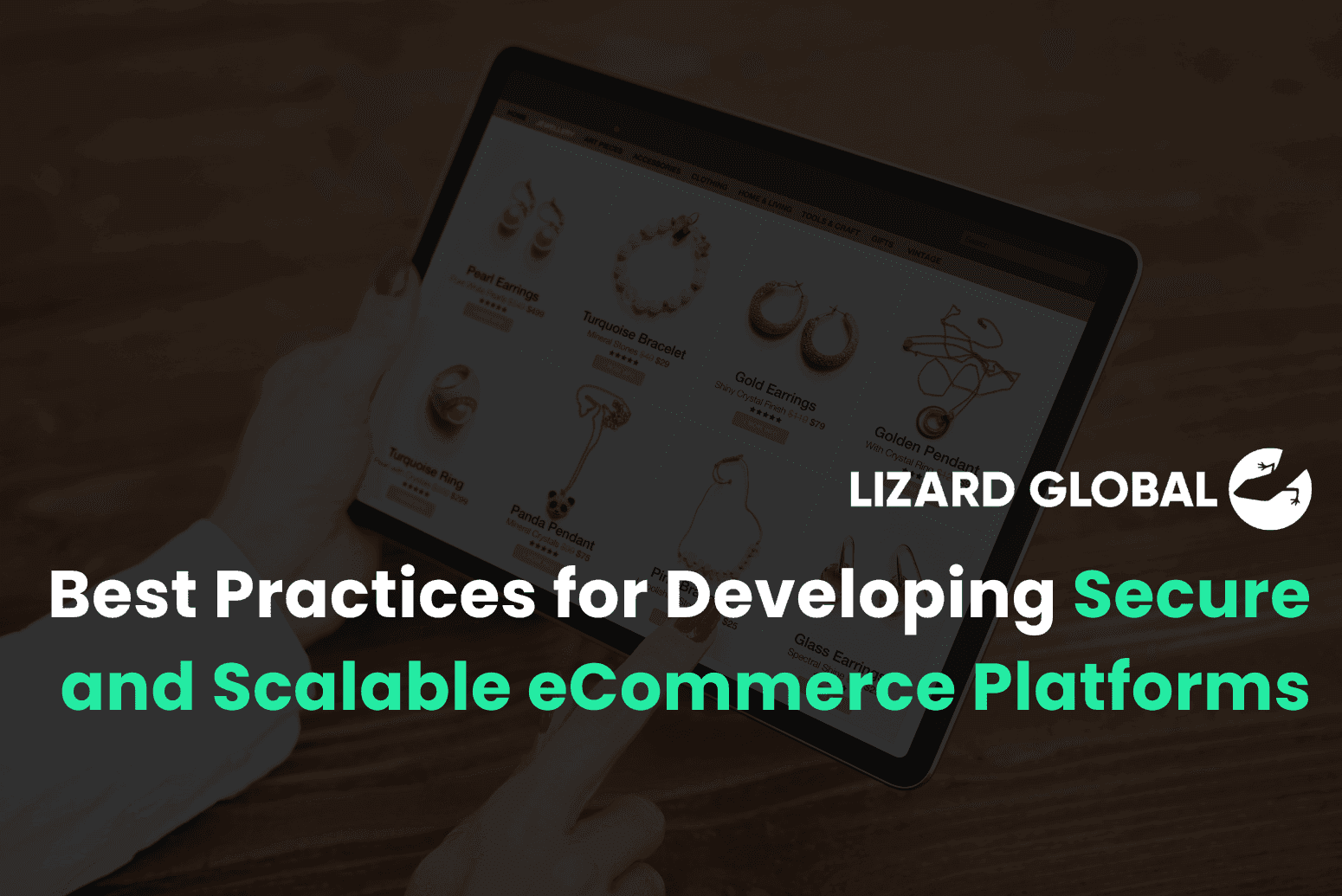Software Development
Lean Analytics
+ 4 more ...
Choosing the Right Business Metrics: A Step-by-Step Guide for Founders

20 May 2025
by Nadiy, Senior Content Writer

20 May 2025
by Nadiy, Senior Content Writer
Software Development
Lean Analytics
Data Analytics
North Star Metrics
Mobile App Development
Web App Development
Choosing the Right Business Metrics: A Step-by-Step Guide for Founders
Table of contents
Contact us
We will get back to you in the next 48 hours.

Choosing the Right Business Metrics A Step-by-Step Guide for Founders
Struggling to track what really drives your startup’s growth? This step-by-step guide helps founders choose the right business metrics, avoid vanity data, and align teams around KPIs that matter.
key takeaways
Your business is growing—but are you measuring what truly matters? Founders often get caught in the seductive trap of vanity metrics: flashy numbers like social media followers, app downloads, or website visits. These can look impressive in pitch decks, but they rarely tell the whole story. The real question every founder should ask is: Are these numbers driving meaningful growth or just boosting egos?
Whether you’re leading a startup or scaling an established digital product, choosing the right business metrics is crucial. The right key performance indicators (KPIs) don’t just help you track progress—they help you make smarter decisions, align your team, attract the right investors, and stay laser-focused on your goals.
In this blog, we’ll walk through a step-by-step process to help you identify, define, and implement the business metrics that will move the needle. Let’s dive in.
What Are Business Metrics and Why Should Founders Care?
Before diving into how to choose them, let’s clarify what we mean by business metrics.
Business metrics, also known as KPIs (key performance indicators), are quantifiable measures used to track the performance of a company’s activities. Unlike vanity metrics—which might make your growth look better than it actually is—real business metrics are directly tied to your strategic objectives.
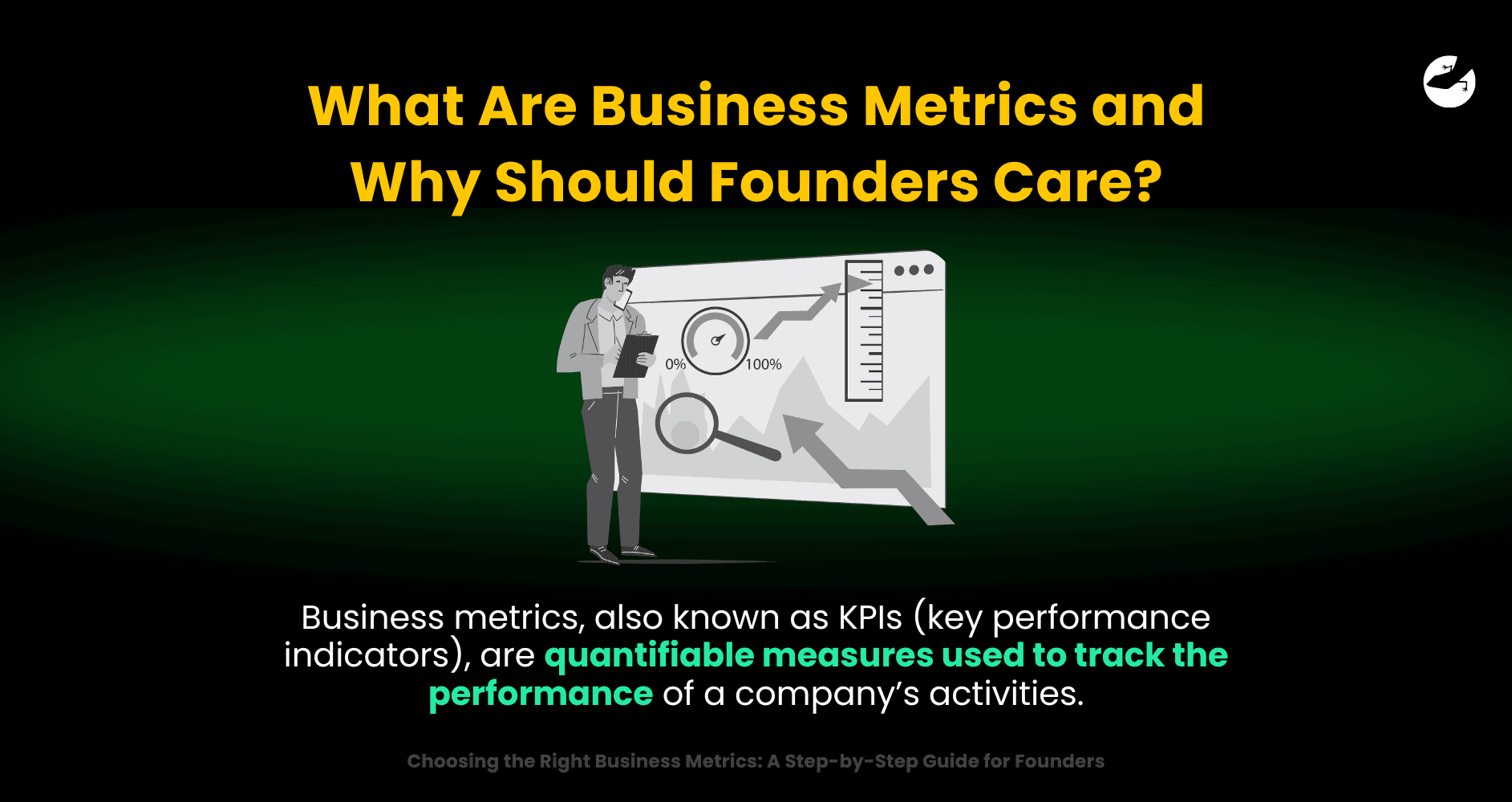
For founders, choosing the right metrics isn’t just a matter of reporting. It’s about aligning your business model, product strategy, and customer experience with measurable outcomes. Without them, you're flying blind.
For example:
- If you're running a SaaS product, tracking Monthly Recurring Revenue (MRR) tells you whether your customer base is growing in a sustainable way.
-If you're launching a mobile app, monitoring Day 1 and Day 7 retention shows whether users are finding real value quickly.
- If you operate an eCommerce platform, conversion rate reveals how well your site turns traffic into actual sales.
- If you're building a two-sided marketplace, match rate (how often buyers and sellers successfully connect) is a key sign of marketplace health.
Choosing Business Metrics That Drive Real Growth
When it comes to scaling a startup, not all numbers are created equal. Founders need more than just analytics—they need clarity. The right business metrics can transform scattered efforts into focused execution, helping you understand what’s working, what’s not, and where to go next.
In the following steps, we’ll walk through a proven process to help you identify and implement metrics that actually move the needle.
Step 1: Start With Your Business Goals
Every meaningful metric is rooted in a business goal. Are you aiming for rapid user acquisition? Sustainable revenue growth? Reduced churn? Increased customer satisfaction?
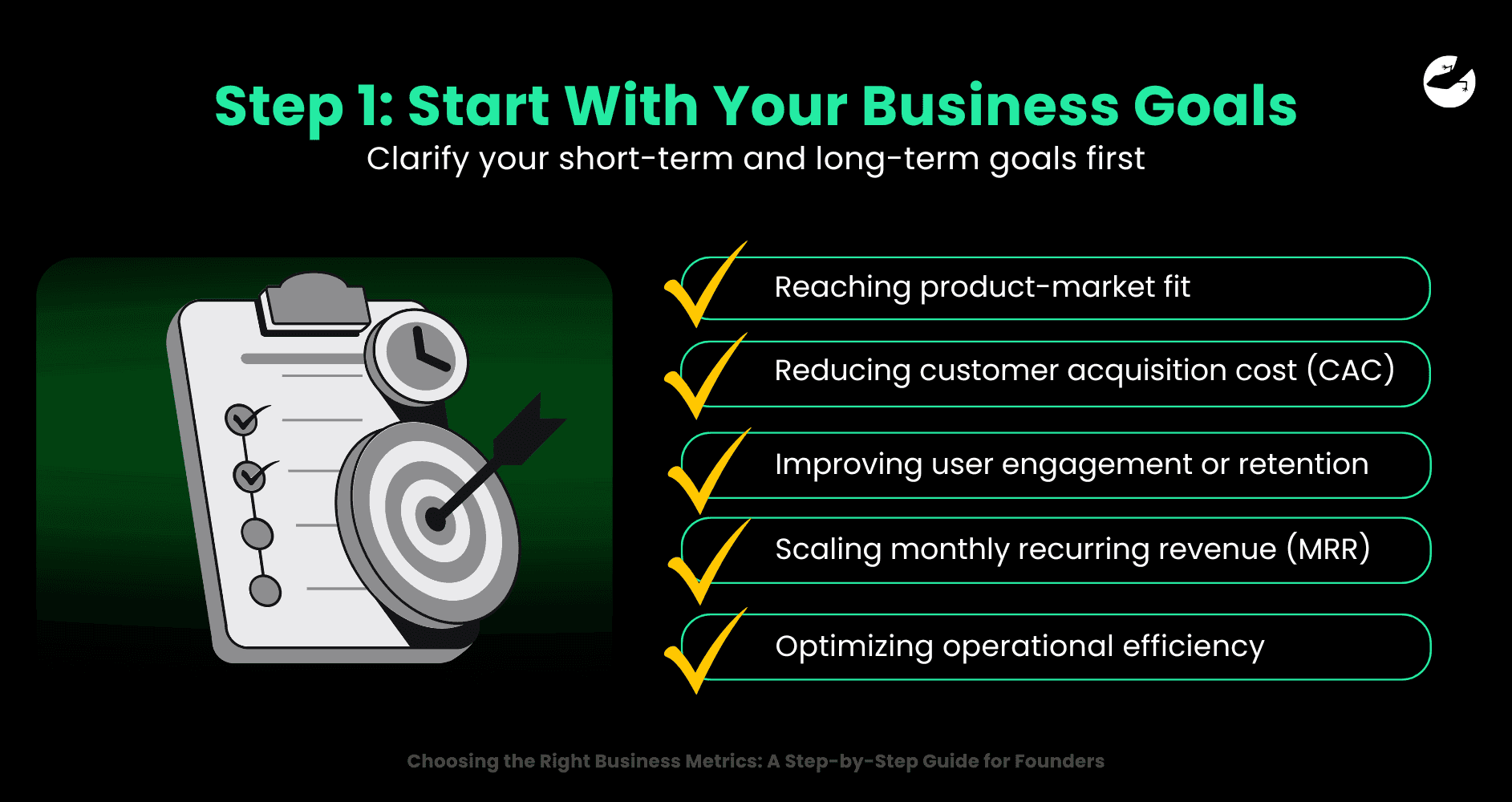
Here’s where many founders stumble: they track too many metrics or the wrong ones. Instead, clarify your short-term and long-term goals first. These might include:
- Reaching product-market fit
- Reducing customer acquisition cost (CAC)
- Improving user engagement or retention
- Scaling monthly recurring revenue (MRR)
- Optimizing operational efficiency
Once these goals are clear, it becomes much easier to identify which metrics align with them. For example, if your goal is sustainable revenue growth, you might track LTV (lifetime value), CAC, and MRR rather than just raw signup numbers.
Step 2: Define Your North Star Metric
Every founder should know their North Star Metric—the one number that best captures the core value your product delivers to users.
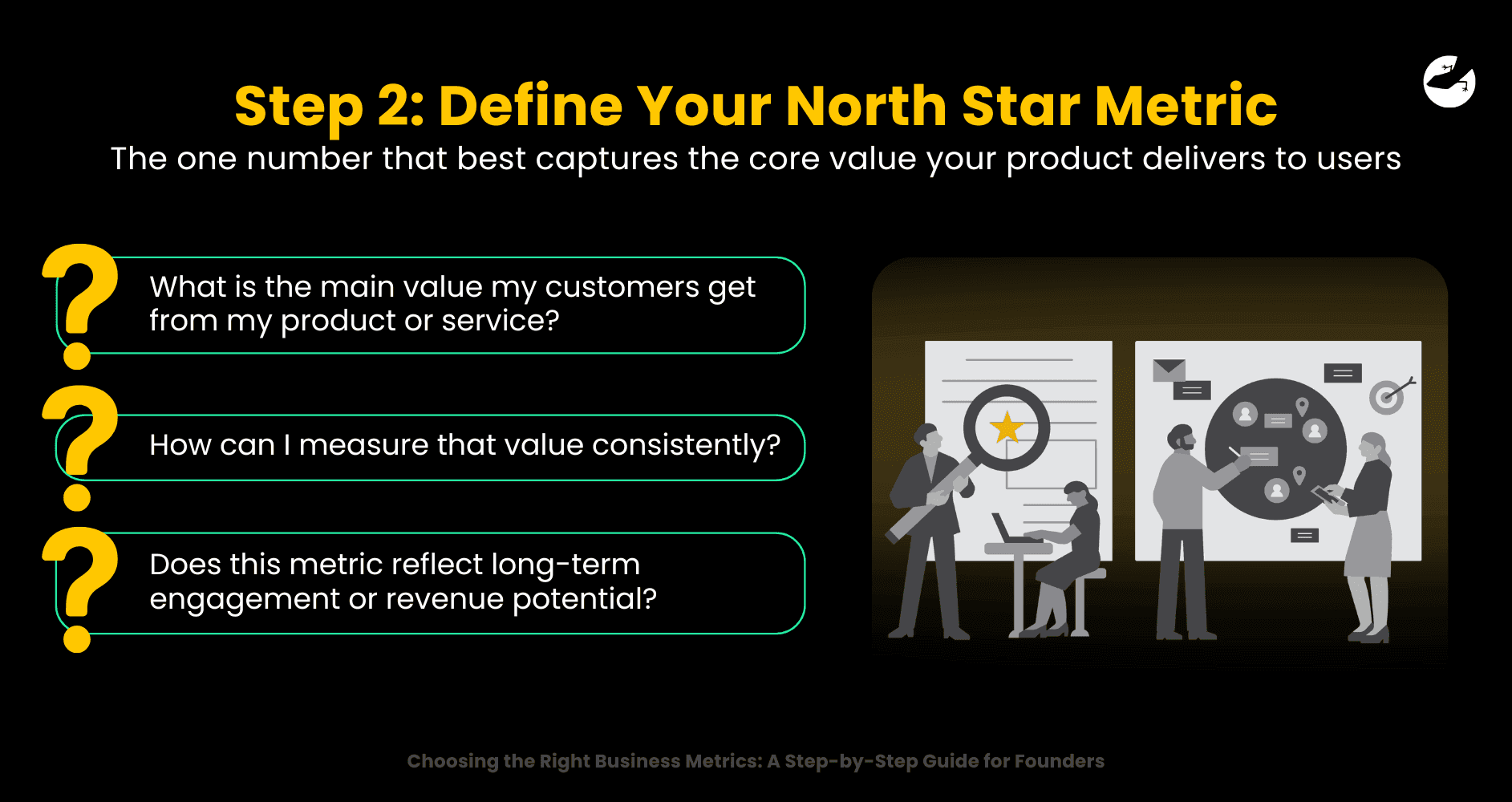
This isn’t just a popular growth hack—it’s a strategic anchor. Your North Star Metric helps align the entire company around a single goal and drives cross-functional focus. For Airbnb, it was nights booked. For Facebook in its early days, it was daily active users.
To define yours, ask:
- What is the main value my customers get from my product or service?
- How can I measure that value consistently?
- Does this metric reflect long-term engagement or revenue potential?
For example, if you're a SaaS platform helping small businesses manage payroll, your North Star Metric might be “payrolls successfully processed per customer per month.” That metric cuts through noise and highlights whether your users are finding repeat value.
Want to find out how much it costs to build your dream app or web app?
Step 3: Identify Leading vs Lagging Indicators
Not all metrics are created equal. One of the most powerful distinctions in business analytics is between leading and lagging indicators.
- Lagging indicators measure past performance (e.g., revenue, profit, churn rate).
- Leading indicators predict future outcomes (e.g., product usage, onboarding completion, sales pipeline volume).
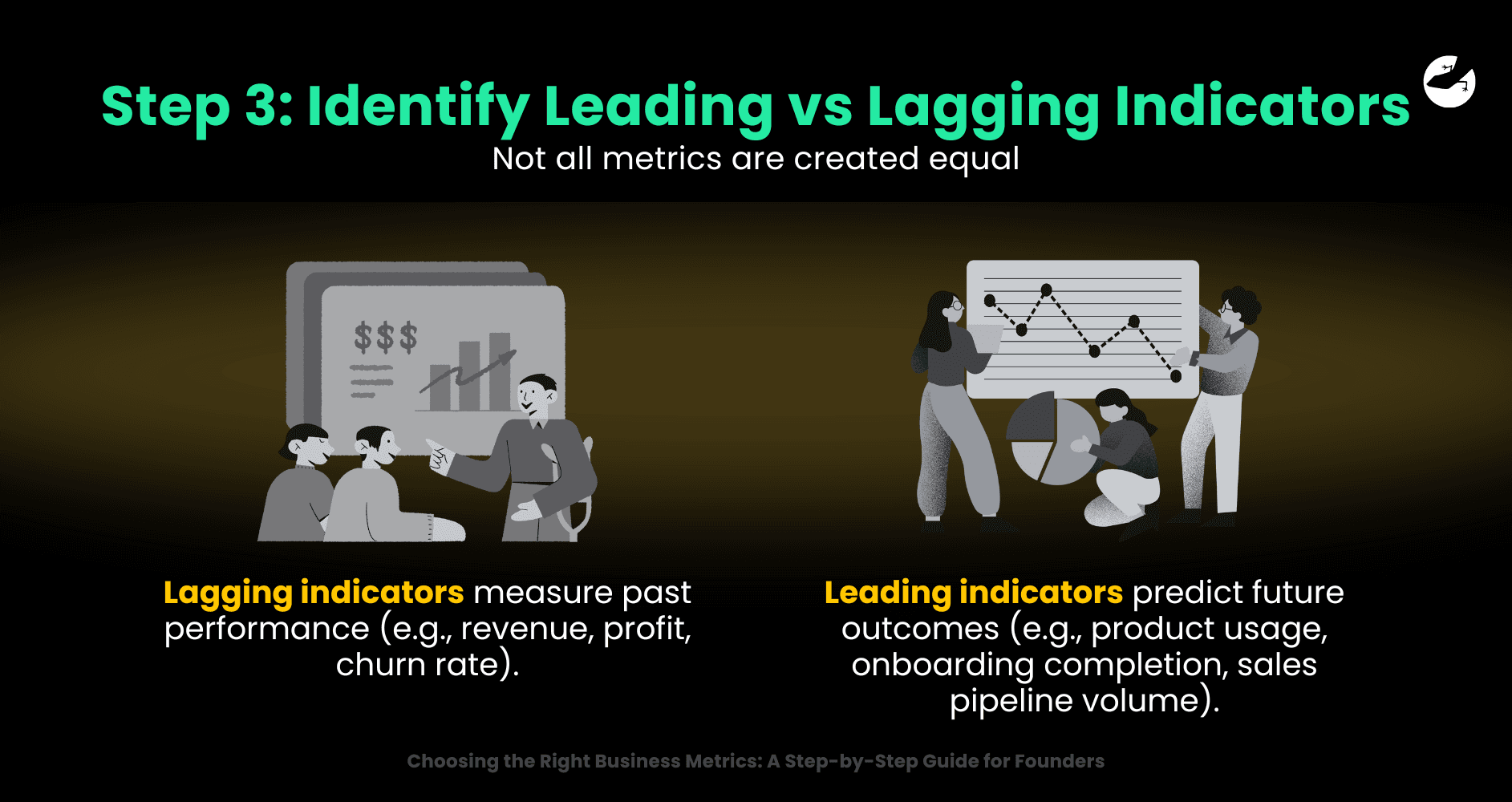
As a founder, focusing only on lagging indicators can cause you to react too late. Instead, supplement them with leading indicators that can guide proactive action.
For instance, if customer churn is a lagging indicator, a leading indicator could be the number of support tickets opened in the first week. If that number spikes, you can intervene before churn happens. This creates a more responsive, data-driven business.
Step 4: Customize Metrics to Your Business Model
Don’t just copy-paste metrics from another startup's pitch deck. Your metrics must reflect the uniqueness of your industry, audience, and growth stage.
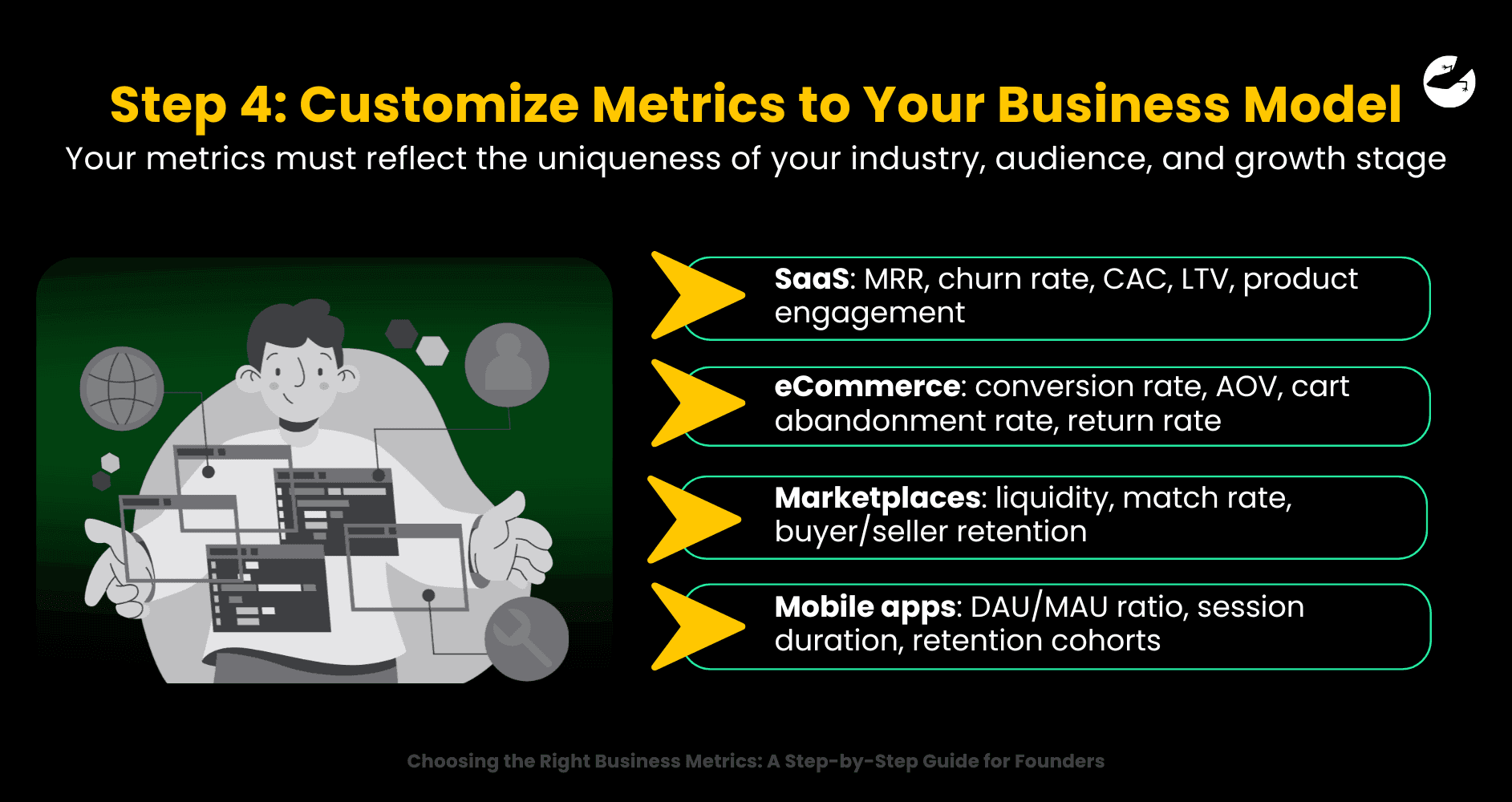
A SaaS business will track very different KPIs than an e-commerce brand or a two-sided marketplace. Here’s a breakdown:
- SaaS: MRR, churn rate, CAC, LTV, product engagement
- eCommerce: conversion rate, AOV (average order value), cart abandonment rate, return rate
- Marketplaces: liquidity, match rate, buyer/seller retention
- Mobile apps: DAU/MAU ratio, session duration, retention cohorts
You might even need to invent a few custom metrics. For example, at Lizard Global, we’ve seen clients succeed with unique metrics like “feature adoption velocity” or “cost per activated user”—custom KPIs that reveal product stickiness and operational efficiency.
Step 5: Align Metrics With Your Teams and Tools
Your KPIs should not live in a dusty spreadsheet or forgotten analytics dashboard. Once you've chosen the right business metrics, they need to be integrated into team workflows, decision-making, and company rituals.
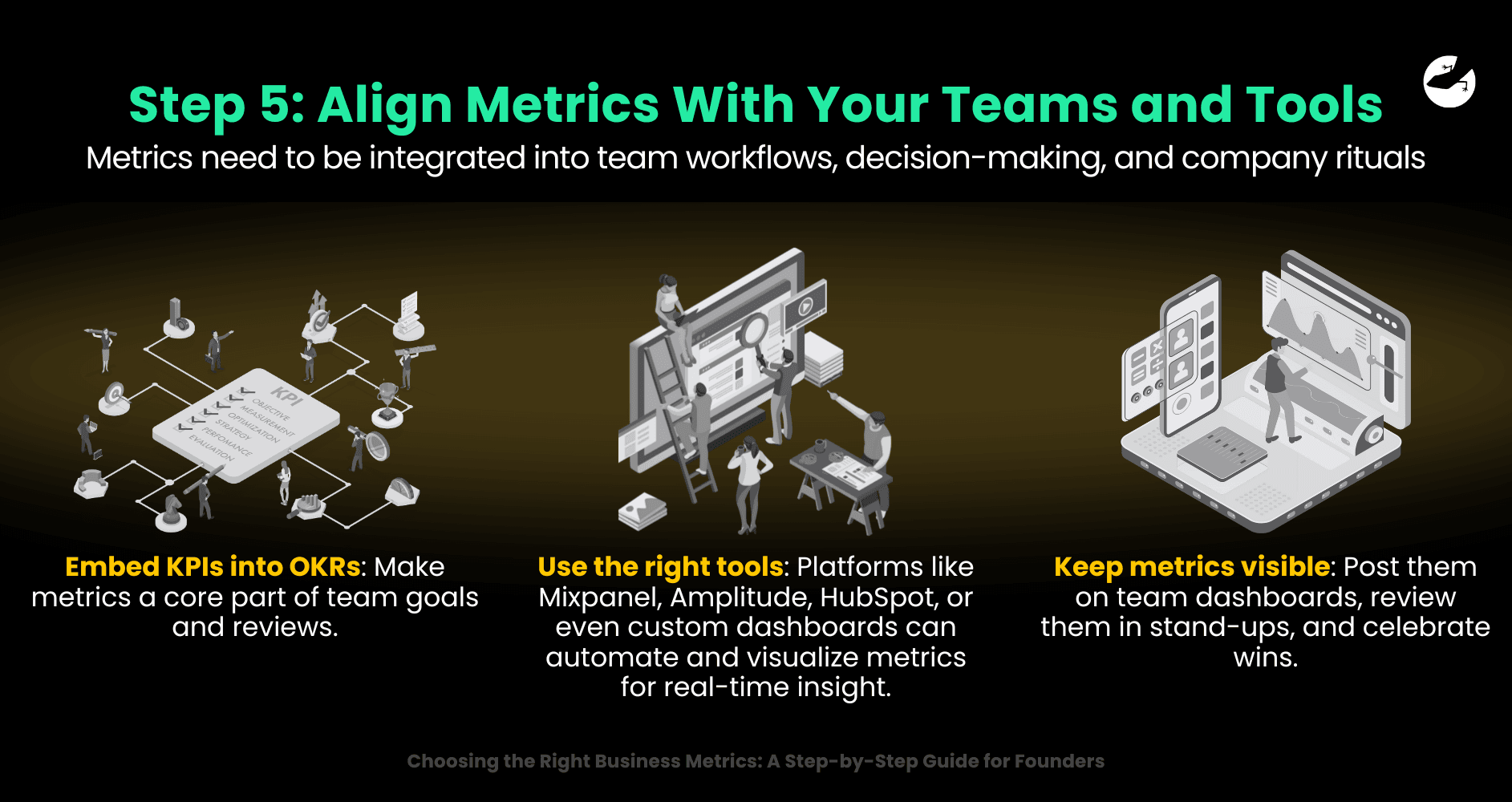
Here’s how:
- Embed KPIs into OKRs: Make metrics a core part of team goals and reviews.
- Use the right tools: Platforms like Mixpanel, Amplitude, HubSpot, or even custom dashboards can automate and visualize metrics for real-time insight.
- Keep metrics visible: Post them on team dashboards, review them in stand-ups, and celebrate wins.
Just as importantly, educate your teams on “why" these metrics matter. When everyone—from developers to marketers—understands the “why,” your business becomes more aligned and data-literate.
Step 6: Revisit and Refine Regularly
Your business isn’t static—your metrics shouldn’t be either. As you grow, your product matures, your users evolve, and your market shifts. That’s why founders need to treat metric evaluation as an ongoing process.

Set quarterly or bi-annual check-ins to ask:
- Are our KPIs still aligned with our goals?
- Have any become irrelevant or misleading?
- Are we measuring too much or too little?
You may start with metrics like activation rate and CAC, but as your product matures, you might shift focus to NPS (Net Promoter Score), customer retention, or expansion revenue.
Refinement is not failure—it’s strategic evolution.
How Lizard Global Helps Founders Track What Truly Matters
At Lizard Global, we understand that choosing the right business metrics isn’t just about analytics—it’s about aligning metrics with your product vision, market fit, and growth strategy.
We help founders and digital product teams:
- Identify your North Star Metric and supporting KPIs
- Design custom dashboards that surface actionable insights in real time
- Optimize user journeysbased on behavior-driven metrics
- Integrate analytics tools like Mixpanel, Firebase, GA4, and more
- Validate metrics through A/B testing, customer interviews, and rapid prototyping
Whether you're a startup founder launching your MVP or a scale-up refining your monetization strategy, we help you move beyond vanity metrics and make data work for you.
Ready to take your product growth to the next level with meaningful metrics? Let’s build something great together—connect with the experts at Lizard Global and let’s build something meaningful—together.
Join 2000+ subscribers
Stay in the loop with everything you need to know

Choosing the Right Business Metrics A Step-by-Step Guide for Founders
Struggling to track what really drives your startup’s growth? This step-by-step guide helps founders choose the right business metrics, avoid vanity data, and align teams around KPIs that matter.
Your business is growing—but are you measuring what truly matters? Founders often get caught in the seductive trap of vanity metrics: flashy numbers like social media followers, app downloads, or website visits. These can look impressive in pitch decks, but they rarely tell the whole story. The real question every founder should ask is: Are these numbers driving meaningful growth or just boosting egos?
Whether you’re leading a startup or scaling an established digital product, choosing the right business metrics is crucial. The right key performance indicators (KPIs) don’t just help you track progress—they help you make smarter decisions, align your team, attract the right investors, and stay laser-focused on your goals.
In this blog, we’ll walk through a step-by-step process to help you identify, define, and implement the business metrics that will move the needle. Let’s dive in.
What Are Business Metrics and Why Should Founders Care?
Before diving into how to choose them, let’s clarify what we mean by business metrics.
Business metrics, also known as KPIs (key performance indicators), are quantifiable measures used to track the performance of a company’s activities. Unlike vanity metrics—which might make your growth look better than it actually is—real business metrics are directly tied to your strategic objectives.

For founders, choosing the right metrics isn’t just a matter of reporting. It’s about aligning your business model, product strategy, and customer experience with measurable outcomes. Without them, you're flying blind.
For example:
- If you're running a SaaS product, tracking Monthly Recurring Revenue (MRR) tells you whether your customer base is growing in a sustainable way.
-If you're launching a mobile app, monitoring Day 1 and Day 7 retention shows whether users are finding real value quickly.
- If you operate an eCommerce platform, conversion rate reveals how well your site turns traffic into actual sales.
- If you're building a two-sided marketplace, match rate (how often buyers and sellers successfully connect) is a key sign of marketplace health.
Choosing Business Metrics That Drive Real Growth
When it comes to scaling a startup, not all numbers are created equal. Founders need more than just analytics—they need clarity. The right business metrics can transform scattered efforts into focused execution, helping you understand what’s working, what’s not, and where to go next.
In the following steps, we’ll walk through a proven process to help you identify and implement metrics that actually move the needle.
Step 1: Start With Your Business Goals
Every meaningful metric is rooted in a business goal. Are you aiming for rapid user acquisition? Sustainable revenue growth? Reduced churn? Increased customer satisfaction?

Here’s where many founders stumble: they track too many metrics or the wrong ones. Instead, clarify your short-term and long-term goals first. These might include:
- Reaching product-market fit
- Reducing customer acquisition cost (CAC)
- Improving user engagement or retention
- Scaling monthly recurring revenue (MRR)
- Optimizing operational efficiency
Once these goals are clear, it becomes much easier to identify which metrics align with them. For example, if your goal is sustainable revenue growth, you might track LTV (lifetime value), CAC, and MRR rather than just raw signup numbers.
Step 2: Define Your North Star Metric
Every founder should know their North Star Metric—the one number that best captures the core value your product delivers to users.

This isn’t just a popular growth hack—it’s a strategic anchor. Your North Star Metric helps align the entire company around a single goal and drives cross-functional focus. For Airbnb, it was nights booked. For Facebook in its early days, it was daily active users.
To define yours, ask:
- What is the main value my customers get from my product or service?
- How can I measure that value consistently?
- Does this metric reflect long-term engagement or revenue potential?
For example, if you're a SaaS platform helping small businesses manage payroll, your North Star Metric might be “payrolls successfully processed per customer per month.” That metric cuts through noise and highlights whether your users are finding repeat value.
Want to find out how much it costs to build your dream app or web app?
Step 3: Identify Leading vs Lagging Indicators
Not all metrics are created equal. One of the most powerful distinctions in business analytics is between leading and lagging indicators.
- Lagging indicators measure past performance (e.g., revenue, profit, churn rate).
- Leading indicators predict future outcomes (e.g., product usage, onboarding completion, sales pipeline volume).

As a founder, focusing only on lagging indicators can cause you to react too late. Instead, supplement them with leading indicators that can guide proactive action.
For instance, if customer churn is a lagging indicator, a leading indicator could be the number of support tickets opened in the first week. If that number spikes, you can intervene before churn happens. This creates a more responsive, data-driven business.
Step 4: Customize Metrics to Your Business Model
Don’t just copy-paste metrics from another startup's pitch deck. Your metrics must reflect the uniqueness of your industry, audience, and growth stage.

A SaaS business will track very different KPIs than an e-commerce brand or a two-sided marketplace. Here’s a breakdown:
- SaaS: MRR, churn rate, CAC, LTV, product engagement
- eCommerce: conversion rate, AOV (average order value), cart abandonment rate, return rate
- Marketplaces: liquidity, match rate, buyer/seller retention
- Mobile apps: DAU/MAU ratio, session duration, retention cohorts
You might even need to invent a few custom metrics. For example, at Lizard Global, we’ve seen clients succeed with unique metrics like “feature adoption velocity” or “cost per activated user”—custom KPIs that reveal product stickiness and operational efficiency.
Step 5: Align Metrics With Your Teams and Tools
Your KPIs should not live in a dusty spreadsheet or forgotten analytics dashboard. Once you've chosen the right business metrics, they need to be integrated into team workflows, decision-making, and company rituals.

Here’s how:
- Embed KPIs into OKRs: Make metrics a core part of team goals and reviews.
- Use the right tools: Platforms like Mixpanel, Amplitude, HubSpot, or even custom dashboards can automate and visualize metrics for real-time insight.
- Keep metrics visible: Post them on team dashboards, review them in stand-ups, and celebrate wins.
Just as importantly, educate your teams on “why" these metrics matter. When everyone—from developers to marketers—understands the “why,” your business becomes more aligned and data-literate.
Step 6: Revisit and Refine Regularly
Your business isn’t static—your metrics shouldn’t be either. As you grow, your product matures, your users evolve, and your market shifts. That’s why founders need to treat metric evaluation as an ongoing process.

Set quarterly or bi-annual check-ins to ask:
- Are our KPIs still aligned with our goals?
- Have any become irrelevant or misleading?
- Are we measuring too much or too little?
You may start with metrics like activation rate and CAC, but as your product matures, you might shift focus to NPS (Net Promoter Score), customer retention, or expansion revenue.
Refinement is not failure—it’s strategic evolution.
How Lizard Global Helps Founders Track What Truly Matters
At Lizard Global, we understand that choosing the right business metrics isn’t just about analytics—it’s about aligning metrics with your product vision, market fit, and growth strategy.
We help founders and digital product teams:
- Identify your North Star Metric and supporting KPIs
- Design custom dashboards that surface actionable insights in real time
- Optimize user journeysbased on behavior-driven metrics
- Integrate analytics tools like Mixpanel, Firebase, GA4, and more
- Validate metrics through A/B testing, customer interviews, and rapid prototyping
Whether you're a startup founder launching your MVP or a scale-up refining your monetization strategy, we help you move beyond vanity metrics and make data work for you.
Ready to take your product growth to the next level with meaningful metrics? Let’s build something great together—connect with the experts at Lizard Global and let’s build something meaningful—together.
Join 2000+ subscribers
Stay in the loop with everything you need to know
FAQs

What are the most important business metrics for startups?
How do I know if I'm tracking vanity metrics?
How often should founders revisit their KPIs?
What are leading vs lagging indicators in business metrics?
What tools should startups use to track business metrics?
Why is data-driven decision making important for founders?
Can business metrics help with investor pitching?
How can I align my team around business metrics?
similar reads



